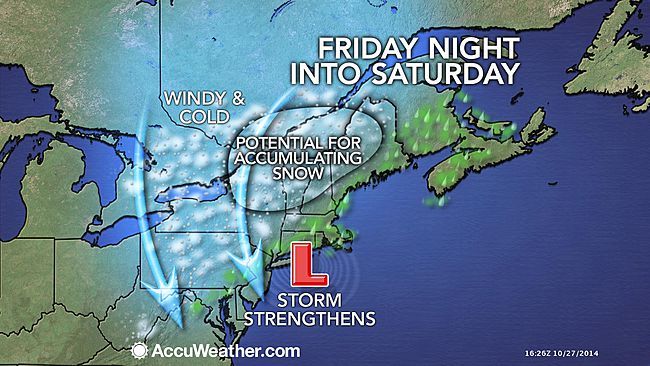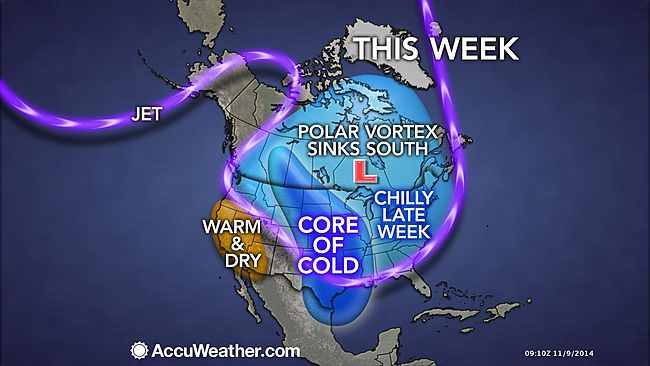WKN Weer, Klimaat en Natuurrampen
Lees alles over het onstuimige weer op onze planeet, volg orkanen en tornado's, zie hoe vulkanen uitbarsten en hoe Moeder Aarde beeft bij een aardbeving. Alles over de verwoestende kracht van onze planeet en tal van andere natuurverschijnselen.



Heavy snowfall Wednesday night and Thursday morning covered parts of Montana, Wyoming and western South Dakota.
As of Thursday morning, up to 6-8 inches accumulated on portions of the Black Hills in South Dakota, and Cut Bank and Lewistown in Montana had their first snowfall of the season. The early snowfall has caused over 30,000 power outages in Calgary, Alberta, and threatened to cause power outages in the Rockies and northern Plains of the United States.
AccuWeather Senior Meteorologist Brett Anderson said "Many times when we see an outbreak like this, this early in the season, it doesn't last and will go back to normal pretty quickly."
Accuweather
As of Thursday morning, up to 6-8 inches accumulated on portions of the Black Hills in South Dakota, and Cut Bank and Lewistown in Montana had their first snowfall of the season. The early snowfall has caused over 30,000 power outages in Calgary, Alberta, and threatened to cause power outages in the Rockies and northern Plains of the United States.
AccuWeather Senior Meteorologist Brett Anderson said "Many times when we see an outbreak like this, this early in the season, it doesn't last and will go back to normal pretty quickly."
Accuweather


De tering, dat ziet er allemaal koud uit 
"The only sight worse than a sad dwarf is a very sad dwarf"
"Met dubbel s welteverstaan"
"Met dubbel s welteverstaan"


De winter wilt hier nog niet op gang komen, normaal hebben we rond deze tijd al sneeuw gezien maar vandaag is het 33 graden!


Het is nog steeds vrij vroeg toch? Het is nog geen oktober...quote:Op donderdag 25 september 2014 20:42 schreef jeroen1976 het volgende:
De winter wilt hier nog niet op gang komen, normaal hebben we rond deze tijd al sneeuw gezien maar vandaag is het 33 graden!


Klopt, maar meestal hebben we hier wel al een aantal witte ochtenden gezien tegen het einde van September. Vorige week is het een aantal nachten -5 graden geweest en het gras en plasjes water waren bevroren.quote:Op donderdag 25 september 2014 21:00 schreef aloa het volgende:
[..]
Het is nog steeds vrij vroeg toch? Het is nog geen oktober...
Met de +34 op dit moment is het vandaag officieel een warmte record in zuid Saskatchewan, het vorige record was +31 in 1997.
En het was vandaag -17 in 1928 dus het kan zeker al winter zijn hier rond deze tijd van het jaar!


Eindelijk een beetje vrieskou hier, -2 op dit moment (13:00) met een windchill van -7. Toch maar m'n jas aan doen voor lunch. Binnen een uurtje gaat er sneeuw vallen!


GFS verwacht meer dan een halve meter sneeuw. In combinatie met de storm kan dat voor behoorlijk wat overlast zorgen.


.quote:Op vrijdag 31 oktober 2014 03:09 schreef aloa het volgende:
GFS verwacht meer dan een halve meter sneeuw. In combinatie met de storm kan dat voor behoorlijk wat overlast zorgen.
[ afbeelding ]
Jammer dat we dat hier niet hebben
ph'nglui mglw'nafh Cthulhu R'lyeh wgah'nagl fhtagn


Bronquote:Typhoon Nuri forecast to kick-start a parade of cold outbreaks in Eastern U.S.
Powerful Typhoon Nuri is expected to generate a ripple effect of chilly U.S. weather in November, after the storm deepens to potentially record-setting pressures in the Bering Sea later this week.
Typhoon Nuri has weakened since Monday, now the equivalent of a category 4 hurricane. Remarkably, the typhoon remained a category 5 for 24 hours, and maintained its 180 mph winds for at least 18 hours. Nuri is now tied with Typhoon Vongfong as the strongest storm of 2014.
But Nuri’s superlatives likely won’t end there. Over the next few days, Nuri is forecast to track north through the West Pacific, losing its tropical cyclone characteristics, and interacting with a strong jet stream. By the time the low pressure system reaches the Bering Sea, west of Alaska, it is forecast to have deepened to a pressure less than 920 mb — on par with some of the deepest cyclones on record. The lower the pressure, the more intense the storm is.
On Monday night, the European model was forecasting the cyclone to drop 36 mb in 18 hours to an incredible low pressure of 916 mb. This would likely be the lowest pressure ever recorded in the Bering Sea — the previous record for Alaska is 927 mb at Dutch Harbor in 1977. It would also come very close to the lowest extratropical pressure on record for any location, which is 913 mb, set in the North Atlantic in 1993.
Combined with some other atmospheric patterns that favor cold weather in the eastern U.S., Nuri’s extremely low pressure is poised to kick-start a domino effect on weather in the Northern Hemisphere over the next few weeks. In particular, it will spur a parade of cold air outbreaks across the central and eastern U.S. in November.
The storm’s deep low pressure will build a strong ridge in the eastern Pacific and over western North America. This, in turn, will force cold, Arctic air to surge south in the central and eastern U.S. over the next few weeks.
Arctic Oscillation forecasts also warn of cold times to come. The Arctic Oscillation (AO) is an indicator of the strength of the polar jet stream, which can effect how much Arctic air reaches the U.S. A positive AO suggests that cold, Arctic air will stay north. A negative AO, or weaker polar jet stream, opens the door for that cold air to spill south into the lower 48. Global models are predicting a dramatic shift into negative territory for the AO over the next week.
The GFS forecast of the Arctic Oscillation through November 12 shows a dramatic dive into negative territory, opening the door for cold air outbreaks across the U.S. (weatherbell.com)
GFS forecast of the Arctic Oscillation. (Weatherbell.com)
“The typhoon does appear to be contributing to the amplifying pattern by phasing with a trough coming off of East Asia,” said CWG’s Matt Rogers. “Amplifying that trough in turn amplifies more ridging downstream over the North Pacific toward Alaska.”
In addition to the powerful Bering Sea storm, favorable activity in the tropics and a warm pattern in the very high levels of the atmosphere are likely playing a part in the AO’s plunge to negative. All of these factors are expected to unite and deliver chilly November temperatures to the eastern U.S. The good news is that while this pattern does favor cold air outbreaks, we will have periods of warmer weather in between.


As the polar vortex gets displaced to the south, the door will open for arctic air to plunge over the most of the United States as the new week progresses.
Only the Southwest, Hawaii, Alaska and South Florida will escape the grip of the upcoming arctic blast that the polar vortex can be blamed for.
"The polar vortex is a large pocket of very cold air, typically the coldest air in the Northern Hemisphere, which sits over the polar region," stated AccuWeather.com Senior Meteorologist Alex Sosnowski.
"Occasionally, this pocket of very cold air can get dislodged farther south than normal, leading to cold outbreaks in Canada and the U.S."
Only the Southwest, Hawaii, Alaska and South Florida will escape the grip of the upcoming arctic blast that the polar vortex can be blamed for.
"The polar vortex is a large pocket of very cold air, typically the coldest air in the Northern Hemisphere, which sits over the polar region," stated AccuWeather.com Senior Meteorologist Alex Sosnowski.
"Occasionally, this pocket of very cold air can get dislodged farther south than normal, leading to cold outbreaks in Canada and the U.S."


Accuweather: Heavy snow on I-15 near Monida, MT, Idaho DOT webcam shows: http://t.co/gkYxRmg6TG Radar: http://t.co/mUwPtD7na6


Hier in Denver, Colorado is de temperatuur zojuist in 2 uur tijd van 15 naar 0 graden gedaald, en is nog steeds dalende. De eerste vlokjes sneeuw beginnen nu ook te vallen. Sommige mensen in korte broek en t-shirt zijn totaal verrast, maar het was gisteren dan ook nog 23 graden.
Bizar hoe snel het weer kan omslaan, maar ik geniet er dest te meer van
Bizar hoe snel het weer kan omslaan, maar ik geniet er dest te meer van


Bizar!quote:Op maandag 10 november 2014 20:23 schreef Sjouveur het volgende:
Hier in Denver, Colorado is de temperatuur zojuist in 2 uur tijd van 15 naar 0 graden gedaald, en is nog steeds dalende. De eerste vlokjes sneeuw beginnen nu ook te vallen. Sommige mensen in korte broek en t-shirt zijn totaal verrast, maar het was gisteren dan ook nog 23 graden.
Bizar hoe snel het weer kan omslaan, maar ik geniet er dest te meer van
|
|






















